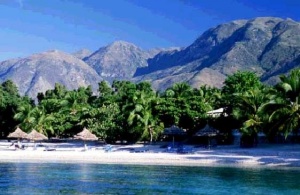Beyond disaster - what next for Haiti tourism?

After a warning from Haiti’s Prime Minister that the eventual death toll could top 100,000, governments and aid agencies from around the world are working to channel personnel and supplies to the battered capital Port au Prince.
There’s no doubt that the country’s most unprecedented natural disaster will be met with a swift outpouring of support from around the globe, with aid coming from governments and individuals alike. However the disaster will also prove a bitter blow to the country’s tourism economy, just as it was poised to return from the wilderness.
Haiti is planning a new international airport and a state-of-the-art ocean liner among ambitious plans to revive its tourism economy following years of political turmoil that plunged the former French colony into abject poverty.
Last October Haitian Tourism Minister Patrick Delatour confirmed the government had signed a US$30m deal with Venezuela for the construction of an international airport in Cap-Haitien, its second-largest city.
In December, Royal Caribbean Cruises began send its new Oasis of the Seas, the largest cruise ship in the world, to a weekly stopover at the beach resort of Labadee. Royal Caribbean is spending $55 million on building a cruise ship pier and attractions.
ADVERTISEMENT
Only last week Choice Hotels International announced plans for two new hotels in Haiti, making it the first global hotel brand to open an operation on the island. Both hotels will be located in Haiti’s historic township of Jacmel.
Other plans include the construction of a road linking Labadee and Haiti’s World Heritage Site, a park containing the Citadelle Laferriere fortress and the Sans Souci palace built by Henri Christophe, a leader of the slave revolt that freed Haiti from French rule in 1804.
The mystique of its voodoo culture and sandy beaches made Haiti one of the gems of the Caribbean. Club Med once operated a beach resort here. But successive years of political violence decimated the tourism economy. Grinding poverty has also discouraged tourism. Some 70 percent of Haiti’s 9 million people live on less than $2 a day.
Former US President Bill Clinton, now the U.N. special envoy to Haiti, has been lobbying foreign investors to look toward Haiti. On a visit to Labadee and Sans Souci, he said: “There are some really good shops in Port-au-Prince for art of all kinds but there should be a few centers around the country.”
Clinton was also hoping to ease U.S. government travel warnings for Haiti. He also suggested Haiti could lure 4 million visitors a year, putting it on par with the heavyweights of Caribbean tourism, Cancun, Mexico, which last year drew 4.7 million, the Bahamas, 4.3 million and the Dominican Republic, 4.2 million.
Haiti currently receives 900,000 visitors per annum, but about 600,000 of those come on cruise ships and don’t stop over, and an estimated 350,000 are Haitians expats returning to visit family.
The immediate short term impact of the earthquake will put tourism firmly on the back seat. However, the unprecedented nature of this disaster presents an opportunity for the international tourism community to initiate a plan for tourism to be an integral part initiating Haiti’s recovery.

